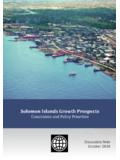Transcription of Framework for Creating a Smart Growth Economic …
1 Office of Sustainable CommunitiesSmart Growth ProgramUnited StatesEnvironmental ProtectionAgencyFRAMEWORK FOR Creating A Smart Growth Economic DEVELOPMENT STRATEGY: A TOOL FOR SMALL CITIES AND TOWNSEPA 231-R-15-003 January 2016 Contact: Melissa Kramer Office of Sustainable Communities Environmental Protection Agency 1200 Pennsylvania Ave. NW (MC 1807T) Washington, DC 20460 Tel 202-564-8497 All photos courtesy of EPA. i TABLE OF CONTENTS I. Introduction .. 1 II. Getting Started: Smart Growth Economic Development Key Concepts .. 3 III. Preparing a Smart Growth Economic Development Strategy .. 6 STEP 1. Select a Focus Area .. 6 STEP 2. Define the Context .. 6 STEP 3. Set Goals .. 7 STEP 4. Identify Existing Assets and Barriers .. 15 STEP 5. Select the Right Tools .. 15 I. INTRODUCTION Many small and mid-sized cities around the United States are struggling because their economies were built largely on a single Economic sector that has changed significantly.
2 For example, at one time jobs might have been heavily concentrated in industries like logging, mining, or manufacturing, but technology and market forces have transformed these sectors, and they no longer employ a large workforce. Changing circumstances, such as those caused by resource depletion, globalization, or shifts in consumer preferences, can shake the Economic foundations of these communities, leaving people without jobs and cities without a healthy tax base. Rather than simply seeking to attract major employers to replace these lost jobs, several cities have tried a different method to anticipate and overcome some of these challenges. This emerging shift toward place-based approaches to Economic development can go by various names. This document uses the term Smart Growth Economic development to refer to a strategy that builds upon existing assets, takes incremental actions to strengthen communities, and builds long-term value to attract a range of investments.
3 This Smart Growth Economic development tool is a step-by-step guide to building a place-based Economic development strategy. The Environmental Protection Agency (EPA) developed this tool with the assistance of CH2M Hill and Strategic Economics as part of a Smart Growth Implementation Assistance project in Kelso, The tool is intended for small and mid-sized cities, particularly those that have limited population Growth , areas of disinvestment, and/or a struggling economy. This tool begins with an overview of key concepts for a Smart Growth Economic development strategy (Chapter II). Next, it covers the five steps for preparing a Smart Growth Economic development strategy (Chapter III): 1. Select the focus area. 2. Define the context. 3. Set the goals. 4. Identify existing assets and barriers. 5. Select the right tools. This step-by-step process for preparing a Smart Growth Economic development strategy is based on six principles: 1. Make the distinction between Growth and investment.
4 2. Be tactical and strategic. 3. Be focused. 4. Start where there is already momentum. 5. Find the right partners for specific goals. 6. Communicate and coordinate. 1 For more information about the project and an example of the tool in action, see: EPA. Using Smart Growth Strategies to Foster Economic Development: A Kelso, Washington, Case Study. 2015. 1 Creating a robust Economic development strategy often takes a concerted effort of multiple partners coming together around a common goal. Staff from municipal governments and regional Economic development organizations, nonprofit organizations seeking to help revitalize communities, and other stakeholders could use this tool to help guide their work. It presents a Framework for information to gather, issues to consider, and potential approaches to explore. Every community and place is different, and communities can modify and refine this tool based on local conditions.
5 2 II. GETTING STARTED: Smart Growth Economic DEVELOPMENT KEY CONCEPTS Many communities are finding success cultivating a competitive advantage by using their unique assets to attract new investment and support existing businesses. These place-based assets might include residents and their skills; local architecture and infrastructure; academic, technical, and medical institutions; local and regional business and employment concentrations; cultural, natural, and artistic resources; and general quality of life. What distinguishes Smart Growth Economic development from conventional Economic development is the emphasis on building on these existing community assets, rather than pursuing jobs or tax base Growth without particular regard for location or synergies among existing assets. The three core components of a Smart Growth Economic development strategy are supporting businesses, supporting workers, and supporting quality of life ( Exhibit 1) . Supporting Businesses.
6 Supporting and expanding existing businesses and attracting new businesses contribute to Economic development in several key ways, including helping businesses create jobs, encouraging entrepreneurship, enhancing fiscal sustainability by expanding and diversifying the tax base, and improving quality of life with new services and amenities. This component of a Smart Growth Economic development strategy focuses on understanding the current composition and location of businesses, jobs, and potential emerging entrepreneurs in the community. This information can help reveal how well the businesses serve local residents and contribute to quality of life and which industries have the most potential to drive Economic Growth in the future. Targeting key Economic sectors for Growth allows city and regional staff to direct their Economic development efforts in a strategic manner, which helps small towns use their limited resources wisely. This part of the Smart Growth Economic development strategy considers not only the businesses and industries with the greatest Growth potential, but also where these businesses are located and how their location helps the community meet its Economic , environmental, and other goals.
7 Supporting Workers. Workforce development is important to ensuring that residents can successfully compete for employment opportunities and that all residents have the opportunity to benefit from Economic prosperity. The availability of a workforce with a wide range of skills and education levels can help local businesses grow and attract new businesses. By offering residents opportunities to learn skills for a wide range of jobs, workforce development efforts might also reduce the need for residents to commute long distances to find appropriate Exhibit 1. The Smart Growth Economic development strategy has three core components. 3 employment, thereby improving quality of life and reducing pollution from vehicles. This Smart Growth Economic development component focuses on how well the skills and education of the local workforce align with the needs of existing and growing industries and provides insight into what the community could do to help workers better match businesses needs.
8 Supporting Quality of Life. Residents and businesses both value a community with a good quality of life. A variety of factors can improve quality of life, such as a thriving downtown or commercial district with neighborhood-serving shops and restaurants; green and open space; a variety of transportation choices, including options for walking, biking, driving, and public transit; artistic, cultural, and community resources such as museums, public art, community centers, religious institutions, and other community gathering spaces; and medical, technical, and academic institutions. Aesthetic improvements might include green infrastructure such as trees and other vegetation that help improve the pedestrian environment while absorbing rainwater and improving water and air quality. This Smart Growth Economic development element also includes identifying key locations for development and redevelopment in the city s core, including brownfields and infill sites.
9 The step-by-step process for preparing a Smart Growth Economic development strategy (presented in Chapter III) is based on six principles that are useful to consider before beginning: 1. Make the distinction between Growth and investment. Not all communities are necessarily growing. However, in most cases, businesses, individuals, and/or public agencies continue to make investments in the community even during periods of population decline. Building on ongoing investment(s), Exhibit 2. Kelso, Washington. Kelso, Washington, illustrates how a Smart Growth Economic development strategy might build upon and improve conventional Economic development approaches. A major food processer opened a plant in the city s industrial area several years ago. According to city staff, the company has had trouble retaining workers, in part because many workers do not have cars and the factory is not well served by transit. At the same time, residents of the adjacent neighborhood struggle with unemployment.
10 A Smart Growth Economic development approach to the workforce retention problem evaluates ways to more directly connect people and resources across the city with businesses and job opportunities than would be typical with conventional approaches to Economic and workforce development, neither of which tend to be place or neighborhood based. For example, conventional Economic development might not consider a full range of transportation options to address worker mobility. Alternatively, a Smart Growth Economic development strategy might include establishing a program to recruit nearby residents to work at businesses in the city s industrial areas and Creating a transit or active transportation system. For example, a safe and convenient bike route could let workers easily get to and from work without a car. These actions would improve employee retention and help Kelso residents reach much-needed jobs while also making more destinations accessible without a car, reducing traffic congestion and air pollution.














